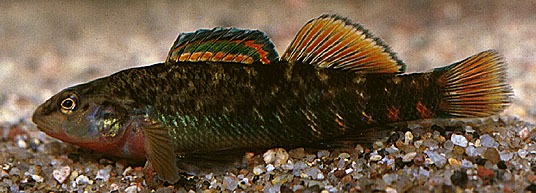Facts
The primary predators of the rainbow darter are larger freshwater fish such as the smallmouth bass (Micropterus dolomieu), stonecats (Notorus flavus), and burbots (Lota lota).
Humans do not eat rainbow darters, and they are considered illegal to use as bait when fishing.
Although many darter species are either endangered or threatened, the rainbow darter is one of the most abundant of all the darter species.
Rainbow darters usually can live up to four years.
The rainbow darter is named for the coloring displayed by the males during mating season, which is olive green with bright blue and orange vertical banding on the body.

Its scientific name Etheostoma (ee-thee-ah´-stoe-mah) is taken from the word 'etheo', meaning to filter, and 'stoma', meaning mouth in Greek. Caeruleum (sair-rule´-ee-um) means blue in Latin.
Lake Phalen in Ramsey County, Minnesota is the only lake in the world where rainbow darters have been found.
For more information and facts about the rainbow darter and other similar species check out this website: http://hatch.cehd.umn.edu/research/fish/fishes/rainbow_darter.html